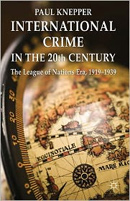International Crime in the 20th Century:
The League of Nation’s Era, 1919-1930

Author: Paul Knepper
New York, NY: Palgrave Macmillan, 2011. 256p.
Reviewer: Sam Bieler | November 2011
Perhaps known best for its dramatic failures as a peace-keeping organization, the League of Nations is given a new lease on life in Paul Knepper’s well-researched International Crime in the 20th Century: The League of Nation’s Era, 1919-1930. Filling an important gap in the historical record, Knepper looks at how the League, generally ineffective in its initial primary role, moved into the field of international crime assessment and prevention as a justification for its continued existence. The author describes the effect this move had on perceptions of international crime. Overall, this is a masterfully sourced work of historical criminology.
International Crime in the 20th Century states the proposition that the League of Nations was an important causal element in the institutionalization of international crime in the early 20th century. In each of six chapters, the work covers a different aspect of international crime and response — from drug trafficking to political murders. Because each of these sections is a relatively stand alone piece, the book reads more like a collection of scholarly articles then as a unified narrative work. Nevertheless, this comes across as a perfectly reasonable method of presentation. Addressing each issue separately makes the work highly readable, and provides the reader with valuable conclusions about how each of these facets of international crime and response developed. For example, Knepper contends that it was the work of League affiliated social scientists that “replaced the moral vocabulary of the Victorian Era with the scientific language of health and hygiene” when dealing with the crime of trafficking in women.
Each of the individual summations is supported with sound scholarship, again the book’s strongest point. A review of the primary sources is all that is needed to see that this book has been carefully planned, sourced, and executed. In every chapter, first-hand accounts from newspapers and policy makers of the era enhance the narrative and drive home Knepper’s points. Nor are these accounts just from well known figures; many of the “bit players” in history feature, adding nuance and perspective at every level of policy.
Unfortunately, it is somewhat of a disappointment that the author does not reach any broader conclusions that would seem warranted by his solid research. Sticking with what some would regard as a relatively minor point, Knepper tantalizes the reader with suggestions that the League’s impact was more significant than it might appear; but these points are not fully explored. Knepper argues that it is “hard to overestimate the importance of the League of Nations in identifying, promoting, and shaping our understanding of crime as an international issue,” but elaborates on this profound conclusion for less than a page. Despite these shortcomings, International Crime in the 20th Century: The League of Nation’s Era, 1919-1930 would be an essential resource for anyone looking to understand the history of international crime and the role of nascent international institutions in the formation of a global response to crime.
Sam Bieler is a Graduate Student in Criminology at the University of Pennsylvania.


